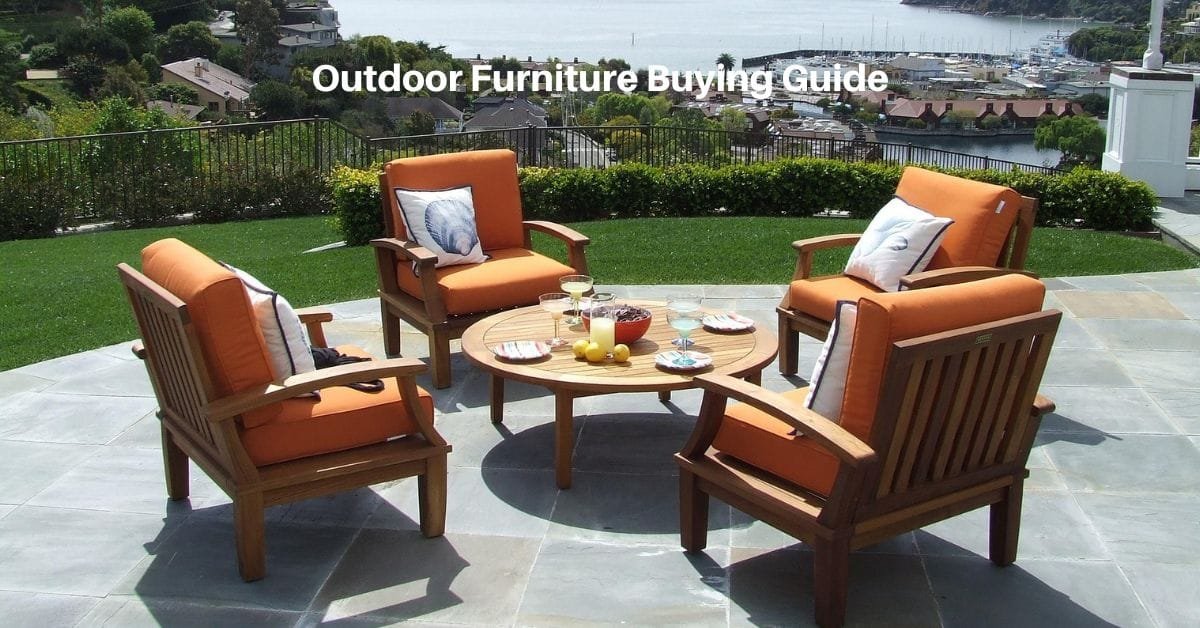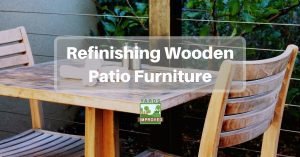Outdoor patio furniture can transform a simple backyard into a lively social space, a tranquil retreat, or a functional area for dining al fresco. However, buying the right furniture involves more than just picking pieces that catch your eye.
It’s about balancing practicality with style and ensuring that the items you choose meet the demands of your climate, lifestyle, and available space. Whether you have a small apartment balcony or an expansive backyard, this guide will help you navigate the options and make informed decisions.
The first step in selecting patio furniture is assessing your specific needs. Start by evaluating the purpose of your outdoor space. Do you plan to host family dinners under the stars, lounge with a book on sunny afternoons, or entertain friends at casual gatherings? Each requires different furniture pieces, and knowing your intended use will guide your choices.
Measure Your Space
Understanding the size and layout of your outdoor area is crucial. A spacious patio can accommodate a sectional sofa or a large dining table. If you have a compact balcony or narrow deck, though, space-saving solutions like foldable furniture or stackable chairs might be ideal.
Use a measuring tape to determine your dimensions, and sketch a rough layout to visualize how pieces will fit. Remember not to clutter it up too much—people need space to walk around comfortably without bumping into chairs or tables.
Consider Your Climate
The weather in your area will have a big impact on the materials you choose. For example, in humid or rainy climates, wood furniture like teak or eucalyptus can resist moisture but may still require regular maintenance. Aluminum and synthetic wicker are great for wet climates as they are rust-resistant and durable.
In sunny regions, fade-resistant materials and cushions are a must to combat prolonged exposure to UV rays. By factoring in your local conditions, you can avoid unnecessary wear and tear and extend the life of your investment.
Establish a Budget
Outdoor furniture comes in a wide range of prices, from affordable options to high-end designs. It’s always tempting to go for the cheapest set available but consider the long-term costs of replacing or repairing poor-quality items. High-quality materials like teak, wrought iron, or powder-coated aluminum may have a higher upfront cost. But they will often save money in the long run because they’ll hold up.
When budgeting, don’t forget to include accessories like cushions, covers, or a patio rug.
Balancing Comfort and Style in Your Outdoor Living Space
Striking the right balance between comfort and style ensures your outdoor area is functional and inviting. Whether you’re planning to create a tranquil retreat or a lively entertainment hub, the right furniture choices can transform your outdoor space into a true extension of your home.
Seating That Invites Relaxation
Comfortable seating is a must-have for any patio setup. Lounge chairs, sectionals, or deep-seating sofas with plush, weather-resistant cushions can create a cozy vibe for lounging or catching up with friends. Pieces with high backs, armrests, and ergonomic designs offer maximum support. For dining spaces, chairs with slightly curved backs or padded seats can make meals more enjoyable.
If you love unwinding with a book or an afternoon nap, consider adding a hammock or daybed. Swing chairs and gliders are also popular for their comfort and playful charm. For year-round comfort, pick cushions and textiles that are fade- and moisture-resistant, and store them in a weatherproof box during inclement weather.
Tailoring the Style to Your Home
Your patio furniture should reflect your taste while complementing the architectural style of your home. For a modern aesthetic, consider sleek metal frames and monochromatic color schemes with pops of bold hues in your cushions or decor. Rustic or farmhouse-inspired patios can benefit from wooden furniture with a weathered finish, paired with neutral or earthy tones.
For a boho or eclectic vibe, mix materials like wicker, bamboo, and metal, and layer patterned cushions, throw blankets, and outdoor rugs for a vibrant and textured look. Coastal designs often incorporate light, breezy colors like whites and blues, paired with furniture made of natural fibers or whitewashed wood.
Multi-Functional Furniture for Small Spaces
If your outdoor area is limited, multi-functional furniture can help you maximize your space without sacrificing comfort or style. Consider pieces like an ottoman that doubles as storage or a bench with a hidden compartment for cushions and throws.
Folding tables and stackable chairs are also ideal for patios that need to be flexible for various activities. Bistro sets or compact dining tables with built-in extensions can offer practical solutions for small balconies or porches.
Accessorizing with Practicality and Style
Once your primary furniture pieces are in place, accessorizing helps add personality and functionality to your outdoor living space. Outdoor rugs can anchor seating arrangements, define spaces, and add a pop of color or texture. Side or coffee tables offer a convenient surface for drinks, books, or decor. Umbrellas or pergolas provide essential shade.
Lighting is another key element that enhances both ambiance and functionality. Solar-powered string lights, lanterns, or LED candles can create a cozy glow for evening gatherings. Task lighting like floor lamps or sconces ensures visibility for specific activities.
Test for Comfort and Durability Before Buying
Whenever possible, test furniture before purchasing. Sit in chairs, lounge on sofas, and feel the cushions to ensure they meet your comfort standards. Pay attention to the quality of the materials and construction, and look for furniture that feels sturdy and well-made. If you’re shopping online, check customer reviews for insights into durability and comfort.
Your patio can become an inviting retreat where you’ll love spending time if you carefully balance comfort and style. Whether hosting a summer barbecue or enjoying a peaceful morning coffee, your outdoor furniture will set the stage for countless memorable moments.
Choosing Materials for Durability and Maintenance
Selecting the right materials ensures your pieces withstand the elements while requiring minimal upkeep. Each material has strengths and aesthetic appeal, so understanding your options can help you make an informed choice.
Wood: Natural Beauty with Proper Care
Wooden furniture offers warmth and timeless charm. That helps make it a popular choice for patios. Hardwoods like teak, eucalyptus, and acacia are well-suited for outdoor use due to their natural resistance to moisture, insects, and decay. Teak, in particular, is highly durable and develops an elegant silvery patina over time if left untreated.
Wood is beautiful and sturdy, but it requires regular maintenance to maintain its appearance and longevity. Periodic sanding, sealing, or oiling helps protect the wood from the elements and prevents cracking or warping. If you prefer low-maintenance options, look for wood treated or finished for outdoor use.
Metal: Strength and Versatility
Metal furniture is prized for its durability and sleek, modern look. Aluminum is a lightweight yet sturdy option that resists rust and corrosion, making it an excellent choice for wet or coastal climates. Steel and wrought iron are heavier and provide a classic or industrial aesthetic, but they require additional care to prevent rust.
Look for powder-coated finishes; they add extra protection against the elements. To enhance comfort, pair metal frames with cushions or padded seating.
Wicker and Rattan: Casual and Cozy
Wicker and rattan furniture bring a casual, inviting vibe to patios and blend seamlessly with bohemian, coastal, or tropical themes. Traditional rattan is made from natural plant fibers. Modern synthetic wicker (made from resin or polyethylene) offers greater durability and resistance to weather and UV rays.
Synthetic wicker furniture often features lightweight aluminum frames for added strength. It’s available in a wide range of colors and designs. To maintain its appearance, wipe down wicker furniture regularly and cover it during prolonged exposure to the sun or rain.
Plastic and Resin: Lightweight and Budget-Friendly
For a low-maintenance, affordable option, consider furniture made from high-quality plastic or resin. These materials are resistant to weather, fading, and cracking, making them ideal for families with children or areas with unpredictable weather.
Modern plastic furniture is no longer limited to basic designs. It offers stylish options that mimic the look of wood or wicker. Resin-based furniture, such as polywood, is particularly durable and eco-friendly, often made from recycled materials.
Cushions and Fabrics: All-Weather Comfort
The cushions and fabrics you choose for your outdoor furniture significantly impact comfort and durability. Look for materials specifically designed for outdoor use, such as solution-dyed acrylic or polyester, which resist fading, moisture, and mildew. Sunbrella and similar brands offer a wide range of colors and patterns for weather-resistant fabrics.
For easy maintenance, select cushions with removable, washable covers and store them during extreme weather conditions to prolong their lifespan. Adding a waterproof storage box to your patio setup can help protect cushions and other accessories when not in use.
Maintenance and Longevity
Investing in outdoor patio furniture is a commitment, and to make the most of it, proper maintenance is crucial. With some care and attention, you can ensure that your furniture remains functional and visually appealing for years. Let’s explore some essential tips for maintaining various types of materials and keeping your outdoor setup in top condition.
Understanding Material-Specific Care
Different materials have unique care requirements, so knowing how to maintain your specific furniture type is key.
- Wooden Furniture:
- Regularly clean wooden furniture with a mild soap solution and a soft cloth to remove dirt and grime. Avoid harsh chemicals that can damage the finish.
- Reapply sealants, stains, or protective coatings yearly to prevent moisture damage, cracking, or fading.
- During harsh weather, use furniture covers or store pieces indoors to protect them from rain, snow, and extreme heat.
- Metal Furniture:
- For aluminum and steel, clean regularly with soapy water and rinse thoroughly to avoid debris buildup.
- Check for rust spots or scratches, especially on wrought iron or steel. Treat rusted areas with a rust remover and touch up with paint as needed.
- Use wax or protective coatings on metal frames to prevent corrosion.
- Wicker or Rattan Furniture:
- Vacuum or brush off dust and dirt, then wipe with a damp cloth. Avoid saturating wicker furniture, as excessive moisture can weaken the fibers.
- If your furniture is synthetic rattan, it’s more weather-resistant but still benefits from regular cleaning and covers during storms.
- Keep wicker pieces out of direct sunlight for prolonged periods to avoid fading.
- Plastic or Resin Furniture:
- Plastic furniture is low-maintenance—simply wash it with soap and water. Avoid abrasive cleaners that may scratch the surface.
- Over time, plastic can become brittle, so consider storing it during the off-season to extend its lifespan.
Cushions and Fabrics
Outdoor cushions and upholstery are often treated to resist water and UV rays, but they still need regular care.
- Cleaning: Remove cushions and clean them based on the manufacturer’s instructions. Most removable covers can be machine-washed or hand-washed with mild detergent.
- Storing: During winter or periods of heavy rain, store cushions in a dry place to prevent mold and mildew. Using waterproof storage boxes is a convenient solution.
- Refreshing: If cushions start to lose their shape, replace the filling to restore comfort and support.
Routine Maintenance Habits
Developing a maintenance routine can significantly extend the life of your furniture.
- Weekly Wipe-Down: Dust off furniture and clean spills promptly to prevent stains.
- Seasonal Checkups: Inspect your furniture at the start and end of each season. Look for signs of wear, loose screws, or rust, and address issues before they worsen.
- Covers and Storage: Invest in high-quality furniture covers to protect against dirt, rain, and UV rays. If possible, store smaller pieces or foldable furniture indoors during extreme weather conditions.
Preparing for Winter Storage
If you live in an area with cold winters, it’s essential to prepare your outdoor furniture for storage to prevent damage.
- Clean First: Before storing, thoroughly clean all pieces to remove dirt, grime, and stains.
- Disassemble Larger Items: For items like dining tables or sectionals, disassemble parts if possible to save storage space and reduce stress on joints.
- Elevate Items: Place furniture on pallets or blocks in your storage space to keep it off cold, damp floors.
Dealing with Damage
Even with proper care, furniture may experience wear and tear over time. Common issues and their fixes include:
- Scratches or Chips in Paint: Touch them up with matching paint or finishes to prevent further damage.
- Fraying Wicker or Rattan: Repair small areas with clear adhesive, or contact a professional for larger fixes.
- Bent or Loose Frames: Tighten screws and bolts, and straighten bent frames if possible. If the damage is extensive, consider replacement parts.
Extending Longevity Through Protection
For an extra layer of protection, consider applying UV-protectant sprays to materials prone to fading and waterproofing sprays to fabric. These treatments add resilience to your furniture and help preserve its original appearance.
By dedicating time to regular maintenance and addressing issues early, you can enjoy your outdoor patio furniture for many years, keeping your outdoor oasis as inviting as the day it was set up.
Choosing the right outdoor patio furniture can transform your backyard into a welcoming and functional extension of your home. The right furniture makes all the difference, no matter how you intend to use the space.
Start by assessing your needs—consider your space, your lifestyle, and the climate in your area. Look for materials and styles that match your aesthetic and provide the durability you need to withstand the elements. Once you’ve made your selections, regular maintenance will help keep your furniture looking its best and performing well for years.
With thoughtful choices and a little care, your outdoor patio furniture can become an integral part of your home, offering comfort, style, and a space to enjoy the beauty of nature.









